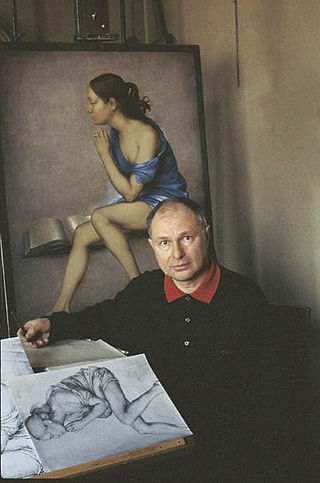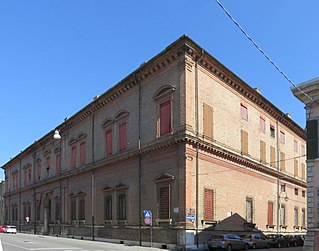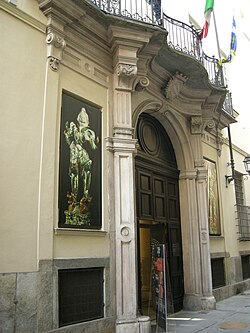
Ugo Nespolo is an Italian artist, painter, sculptor, filmmaker and writer. He lives and works in Turin.

Rome's National Museum of Oriental Art "Giuseppe Tucci" was a museum in Rome, Italy, that was dedicated to the arts of the Orient, from the Middle East to Japan. The museum was located in Via Merulana 248 in the Rione Esquilino.

The Museo Civico d'Arte Antica is an art museum located in the Palazzo Madama in Turin, Italy. It has a renowned collection of paintings from the medieval, Renaissance and Baroque periods. It reopened in 2006 after several years of restorations.

The Museo Nazionale della Magna Grecia, Museo Archeologico Nazionale di Reggio Calabria or Palazzo Piacentini is a museum in Reggio Calabria, southern Italy, housing an archaeological collection from sites in Magna Graecia.

Mario Donizetti is an Italian painter and essayist from Bergamo, Lombardy.

Francesco Podesti was an Italian painter, active in a Romantic style. Together with Francesco Hayez and Giuseppe Bezzuoli, he is considered one of the greatest Italian painters of the first half of the 19th century. He was prolific in his large canvases on historical subjects. He is best known for his fresco work, including those in the Hall of the Immacolata in the Vatican Museum.
Marina Apollonio is an Italian painter and optical artist. She lives and works in Padua.
Giuseppe Veneziano is an Italian painter and one of the leading figures of Italian art groups "New Pop" and "Italian Newbrow".

Enrico Crispolti was an Italian art critic, curator and art historian. From 1984 to 2005, he was professor of history of contemporary art at the Università degli Studi di Siena, and director of the school of specialisation in art history. He previously taught at the Accademia di Belle Arti in Rome (1966–1973) and at the Università degli Studi di Salerno (1973–1984). He was author of the catalogues raisonnés of the works of Enrico Baj, Lucio Fontana and Renato Guttuso. He died in Rome on 8 December 2018.

The Museo di Roma is a museum in Rome, Italy, part of the network of Roman civic museums. The museum was founded in the Fascist era with the aim of documenting the local history and traditions of the "old Rome" that was rapidly disappearing, but following many donations and acquisitions of works of art is now principally an art museum. The collections initially included 120 water-colours by the nineteenth-century painter Ettore Roesler Franz of Roma sparita, "vanished Rome", later moved to the Museo di Roma in Trastevere.

Yumi Karasumaru is a Japanese artist. She lives and works in Bologna, Italy, and Kawanishi, Japan.

Nicola Rubino was an Italian sculptor and painter.
Paolo Ventura is an Italian photographer, artist and set designer based in Milan.

The Museo d'Arte Contemporanea Donnaregina, often known as Museo Madre, or Donnaregina Contemporary Art Museum, is a museum of contemporary art in Naples, in Campania in southern Italy. It is housed in the Palazzo Donnaregina, which was adapted for it by the Portuguese architect Álvaro Siza Vieira. The museum opened in 2005.

The Turin Civic Gallery of Modern and Contemporary Art is an art gallery in Turin, Italy, founded in 1891-1895 and located in 31 via Magenta. With the MAO, Palazzo Madama e Casaforte degli Acaja, the Borgo and the Rocca medioevali, it forms part of the Fondazione Torino Musei. The lower rooms house important reviews and a large collection of video art.

The Palazzo Alliata di Villafranca is former aristocratic palace, now converted into a museum, located just off Via Vittorio Emanuele facing the Piazza Bologni which opens two blocks west of the Quattro Canti intersection, in the ancient quarter of the Albergaria of the city of Palermo, region of Sicily, Italy.

Imago Museum is a modern and impressionist art museum in Pescara, Italy, inaugurated in 2021.

The Museo Giovanni Boldini is a biographical museum, located in the Palazzo Massari, in Ferrara, dedicated to Italian painter Giovanni Boldini. It is one of the three museums located in the palace, being the others the Museo dell'Ottocento and the Museo d'arte moderna e contemporanea Filippo de Pisis. The current museum has been closed for restoration work since the 2012 Northern Italy earthquakes.

















